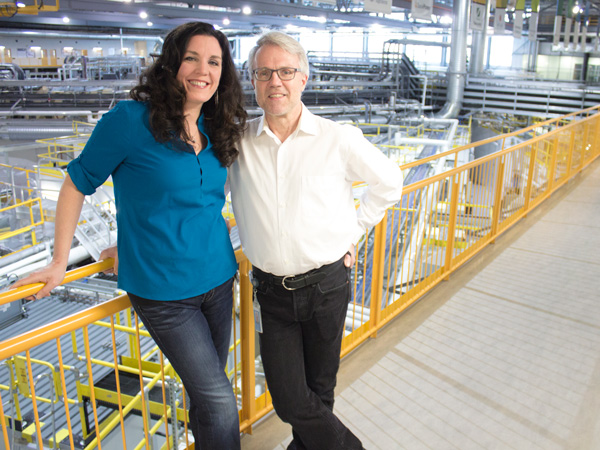News & Events
Social science at the source
 |
| Jennifer Poudrier and Ulrich Teucher at the Canadian Light Source. Photo credit: Mark Ferguson/CLS |
by dee Hobsbawn-Smith
Metaphor and science may seem like odd bedfellows, but to the first-ever social scientists in residence at the Canadian Light Source (CLS), the two are completely compatible.
Psychologist Ulrich Teucher and sociologist Jennifer Poudrier, both associate professors in the College of Arts & Science, moved their offices at the start of January to begin residencies at the CLS that will last until June.
As social scientists, their interest is not in the CLS as a synchrotron radiation facility, but as a unique society of researchers brought together from around the world. Over six months, Poudrier and Teucher will work closely with the CLS scientists to gain insight into the scientists’ relationships to one another and to their work. When they have finished, they will explore ways of sharing their results with the CLS researchers and the greater scientific community.
|
New perspectives
Jennifer Poudrier and Ulrich Teucher will be the first social scientists in residence from January through June of 2015. Carin Holroyd will take up the residency from July through December. |
A pair of $7,500 research grants from the U of S Office of the Vice-President Research will aid Teucher and Poudrier in their projects, while the college’s Division of Social Sciences will cover the cost of releasing them from teaching duties until the summer.
Ulrich Teucher
Teucher, whose father was a German physicist, grew up at the nexus of science and art. As a child, he heard about elementary particles and other aspects of his father’s work at the University of Chicago and at DESY, Germany’s first synchrotron in Hamburg.
“Dad read literature, German and English, Shakespeare and Goethe,” Teucher says. “I grew up in an interdisciplinary household, with sciences and arts as part of the talk.” His father died young, of cancer, with “no language to adequately communicate about his illness.”
Years later, Teucher’s doctoral studies would combine his pediatric cancer-ward nursing experience with literature and psychology in a dissertation on cancer metaphors. “This is the language we use when we talk about cancer, the language my father was missing,” Teucher says.
Working with the Light Source’s host scientists and guests from around the world will help Teucher address many questions about scientists working together in large research facilities.
“It is not so easy for usually competitive scientists to work in groups. As collaborators, guest scientists, host scientists, technicians and directors, all must agree on what and how things are to be done. It is an interesting challenge: how does that work, how do people get organized? How do outsiders collaborate with insiders? How do insiders deal with outsiders? I would expect that host scientists would have different answers than a guest researcher from the College of Medicine or another discipline.”
The CLS residency resonates for Teucher on a personal level as well. “It adds a nice circle to my life,” he says. “It will be interesting for me to look at my dad from that perspective, that of his work. I would like to do surveys, ask questions. Speak with the scientists. Find how they feel about work, about collaboration. I’d like to interview them about what they like about the science they are doing.
“Such huge machines and the smallest particles,” he says in amazement. “Some scientists meet these experiments with awe.”
Jennifer Poudrier
Jennifer Poudrier is a sociologist trained at the Ph.D level in communication information technology: the way information and knowledge are shaped by or shape society. Her interest is in looking at the ways society and science interact—how scientific facts are social enterprises. Through her research, she also hopes to “humanize” the hard science work undertaken at the CLS.
“The work of a sociologist is to show how humans and society work at a problem,” she says, “and to illustrate that [scientists are] people doing scientific work and that it is a social process. … Despite common conceptions, scientific work is really messy, not just scientists in tidy labs and lab coats. A lab is full of messy social elements, like people, politics, hierarchy—everything that is social.”
Poudrier is also interested in looking at the relationship between humans and machines.
“Humans build machines, but when they are working with it, the machine shapes their interactions and behaviors. When the beam line [at CLS] goes up, it runs for 24 hours and people have to stay overnight, so the maintenance of the machine requires humans to change their activities. [You may] think of it as a pristine white coat sci-fi place, but it looks like a manufacturing garage, with tinfoil covering machines, and things under construction. It’s clear that human activity takes place there.”
Like Teucher, Poudrier is fascinated by the metaphors people use for science. “One metaphor that interests me, especially in the context of the Canadian Light Source, is around laboratory light. I’ll be shining a light on what is happening in the lab, which uses light to look at minute and specific specimens. We’re all learning to see.”